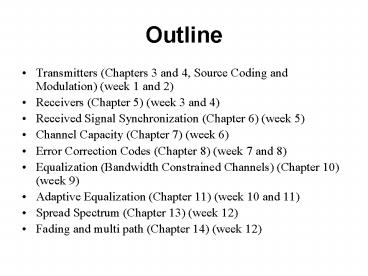Outline PowerPoint PPT Presentation
Title: Outline
1
Outline
- Transmitters (Chapters 3 and 4, Source Coding and
Modulation) (week 1 and 2) - Receivers (Chapter 5) (week 3 and 4)
- Received Signal Synchronization (Chapter 6) (week
5) - Channel Capacity (Chapter 7) (week 6)
- Error Correction Codes (Chapter 8) (week 7 and 8)
- Equalization (Bandwidth Constrained Channels)
(Chapter 10) (week 9) - Adaptive Equalization (Chapter 11) (week 10 and
11) - Spread Spectrum (Chapter 13) (week 12)
- Fading and multi path (Chapter 14) (week 12)
2
Digital Communication System
Information per bit increases
Bandwidth efficiency increases
noise immunity increases
Transmitter
Receiver
3
Transmitters (week 1 and 2)
- Information Measures
- Vector Quantization
- Delta Modulation
- QAM
4
Receivers (Chapter 5) (week 3 and 4)
- Optimal Receivers
- Probability of Error
5
Received Signal Synchronization (Chapter 6) (week
5 and 6)
- Receivers
- Carrier Phase Estimation
- Phase Locked Loops
- Decision Directed Loops
- Symbol Timing Estimation
6
Channel Capacity (Chapter 7) (week 7)
- Discrete Memoryless Channels
7
Error Correction Codes (Chapter 8)
- Trellis/Convolution Codes
- Trellis Codes and QAM
NRZI code with memory L1
Trellis for NRZI
Convolution Code Generator
Viterbi Algorithm
QAM set partition via convolution code
8 state Trellis for rectangular QAM
8
Signals for Band Limited Channels (Chapter 9)
(week 10)
- Raised cosine
9
Equalization (Chapter 10 and 11) (week 11 and 12)
- Receivers for Intersymbol Interference
- Decision Feedback Equalization
- LMS Algorithm
- Adaptive Decision Feedback Equalizer
PowerShow.com is a leading presentation sharing website. It has millions of presentations already uploaded and available with 1,000s more being uploaded by its users every day. Whatever your area of interest, here you’ll be able to find and view presentations you’ll love and possibly download. And, best of all, it is completely free and easy to use.
You might even have a presentation you’d like to share with others. If so, just upload it to PowerShow.com. We’ll convert it to an HTML5 slideshow that includes all the media types you’ve already added: audio, video, music, pictures, animations and transition effects. Then you can share it with your target audience as well as PowerShow.com’s millions of monthly visitors. And, again, it’s all free.
About the Developers
PowerShow.com is brought to you by CrystalGraphics, the award-winning developer and market-leading publisher of rich-media enhancement products for presentations. Our product offerings include millions of PowerPoint templates, diagrams, animated 3D characters and more.

